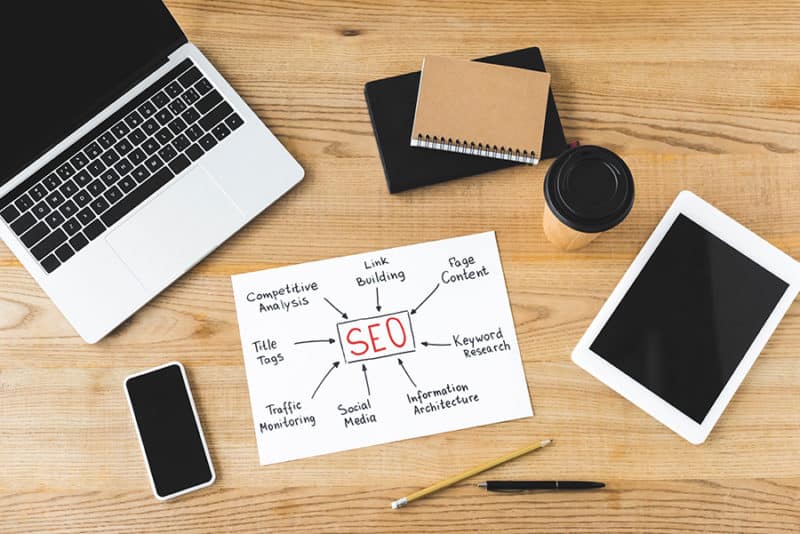Table of Contents
What Is SEO Marketing? – Search Engine Optimization Guide

As you probably already know, SEO stands for “Search Engine Optimization,” and it involves improving websites to boost their visibility on search engine result pages. But then, what is SEO marketing? In simple terms, it’s a strategy to take advantage of the huge pipeline of potential customers that search engines represent.
So, if you really want to see your conversion rates skyrocket, you can’t afford to disregard SEO digital marketing. If you’re still learning the ropes of SEO, then you’re in luck because today, I’m going to go over everything you need to know to leverage it effectively. By the end of this post, you should be an expert in the subject 😎.
Ready to get started?
Table of Contents
What Is SEO Marketing?
Let’s begin with a quick comparison so we’re all on the same page. As you might know already, search engine optimization is all about enhancing your website so search engines will pick it up. SEO for marketing, on the other hand, has to do with using those improvements to achieve specific marketing goals, such as promoting and growing your business online.
In other words, you use SEO to make your website rank higher in the search results, and you use marketing SEO to strategically implement tactics that will get more people interested in what you offer.
Why Is SEO Digital Marketing Important?
Now that you know the answer to “What is SEO in marketing?”, it’s time to go over its importance and the benefits it can provide:
- Stay within your budget: SEO marketing isn’t usually expensive, as it only requires an initial investment that becomes cost-effective in the long run.
- Ensure long-term results: While it’s true that SEO is an ongoing effort, it can lead to lasting results because it will continue to drive traffic and conversions over time.
- Boost online visibility and drive traffic: Solid SEO can help your website show up on the first page of the SERPs (Search Engine Result Pages), which makes it easier for your target audience to find you and attract people who are genuinely interested in what you have to offer.
- Enhance brand credibility and trust: The top-ranking sites are typically associated with high quality and authority, which ultimately leads to trust in your business.
- Integrates seamlessly with other strategies: SEO marketing goes perfectly well with other marketing strategies like social media and digital content marketing and even makes them more effective due to more specific targeting.
- Keep track of your performance: Most SEO marketers and tools out there can give you insights and analytics that will help you keep track of user behavior, preferences, and trends and guide future efforts.
Are There Different Types of SEO Marketing?
There are many types of marketing SEO tactics you can implement, each focused on a different aspect of optimization, but the most popular are on-page SEO, off-page SEO, technical SEO, and local SEO. Let’s go over each of these so I can better explain the commonly asked question of “What is SEO in marketing?”:
On-Page SEO
On-page or on-site SEO has to do with website and page optimization to improve SERP rankings, and it’s what you’re probably most familiar with. The key elements that are typically optimized here include any content, headings, images, meta descriptions, URL structure, keyword placement, internal linking, loading speeds, and so on.
Off-Page SEO
This type of marketing SEO is related to external factors that affect a website’s reputation and popularity. The main tactics used to improve off-page SEO include building high-quality backlinks, guest blogging on authoritative sites, boosting social media engagement, and collaborating with influencers, among others.
Technical SEO
When you want to ensure that search engines can not only crawl but also understand your website, you have to work on your technical SEO marketing. Here, you’ll probably need the help of an SEO marketer or expert because, as the name suggests, you’ll need to improve several technical aspects. Some of these can be site speed, mobile-friendliness, server performance, pagination, site architecture, and structured data markup.
Local SEO
Local SEO is an essential part of SEO digital marketing for small and local businesses because it focuses on improving rankings in local searches. You’ve probably done similar searches yourself, you know, when you look for “grocery stores near me,” for example. In this type of marketing for SEO, you’d have to set up and, of course, optimize a Google My Business listing for your business and manage any online reviews people have left about it.
How Can a Business Start Implementing SEO Marketing?
Now, we’ve reached the exciting part: getting ready to finally leverage marketing SEO and reap the rewards. Let me show you how to do it:
1. Understand how your target search engine works
SEO for marketing can sound daunting at first, and that’s precisely why you should learn how search engines’ algorithms work before you even get started on the technical aspects of optimization.
When we talk about search engines, you probably think about the traditional ones, like Google, Bing, and Yahoo!, and you’re right! But YouTube, Amazon, and social media platforms are also search engines, which consider additional factors, such as user engagement or recency, to rank content.
Today, I’m going to focus on traditional search engines, which all work similarly:
1.1 Crawling
Crawlers are automatic programs, or bots, that navigate a website’s content by following links and using sitemaps. As they go around, they collect information about a page’s on-site elements, like content, headings, images, and so on, to help search engines understand what it’s about.
1.2 Rendering
Search engine bots use HTML, JavaScript, and CSS information to load and show a site’s content just like how it’d display to a user. This way, crawlers can get a clearer picture of the user experience of a page.
1.3 Indexing
The next stage of the process involves analyzing a page’s content, metadata, and any other information collected so far and adding it to an index. You can think of this index as a database in which search engines store everything they know about the content and attributes of the web pages they’ve crawled and rendered.
1.4 Ranking
Finally, search engines will use their algorithms to go over that information and other signals, called ranking factors, to determine the order in which indexed pages will show up in the results pages.
2. Start planning your SEO marketing strategy
Now that you can confidently answer the question “What is SEO in marketing?” yourself, it’s time to put everything you’ve learned so far into practice and begin planning your strategy.
Like with any other digital marketing strategy, you should start by defining your goals and expectations. Ask yourself whether you want to increase organic traffic to your website, boost local visibility, improve CTR, generate leads, grow sales, etc., and specify a timeline for achieving your goals.
You should also set a budget and decide which metrics and KPIs you’re going to track and how.
3. Do your research
I know this might be a boring step for most people, but you shouldn’t skip it because it’s crucial to the SEO marketing strategy’s success.
Here, you’ll have to conduct different types of research and analyses, some of which you’re probably already familiar with:
- Audience research: Understand who your target audience is by finding out more about their demographics, their interests, and their pain points. This way, you can tailor your SEO digital marketing strategy to them and increase its effectiveness.
- Competitor analysis: Take a look at what your competitors doing, what type of content they’re producing, and on which platforms to get an idea of where you should start focusing your own efforts.
- Keyword research: I’m sure this rings a bell. Here’s where you look for relevant search terms you can incorporate into your pages and content.
- Content analysis: Audit your existing content and find out whether there are any gaps to patch up or opportunities for improvement. Then, see whether there are any new topics you can cover or popular areas where you can offer more value to your target audience.
- Backlink profile analysis: To determine your site’s authority and credibility, you’ll have to examine its backlink profile. There, you’ll find all of the backlinks you’ve gained, and you’ll be able to gauge their quality and relevance.
I could keep going, but I just wanted to name a few key ones to give you an idea of what this stage of SEO marketing entails. Bear in mind that you don’t have to conduct research in all these areas, only the ones that are relevant to your business and marketing objectives.
4. Implement your SEO marketing tactics
Now it’s time to set things in motion! If you’ve followed all the previous steps to the letter, then you should have a solid foundation for what comes next: actually implementing your tactics.
This can be anything from creating new, optimized content or updating existing pieces with more relevant keywords or internal links to writing guest posts, responding to reviews, making your website more mobile-friendly, or even enhancing user experience.
Remember that the tactics you will implement will be determined by the goals you’re after and by your audience’s particular characteristics.
5. Audit your results
Finally, you need to discover whether your SEO marketing strategy is actually working! To do that, you need to track and analyze the metrics and analytics you defined in the planning stage of this process.
There are several online tools and platforms you can use to do that yourself, or you can enlist the help of a professional SEO marketer to do the heavy lifting for you. Regardless of your approach, the information you collect will help inform your strategy and guide future efforts in the right direction.
Wrapping Up
And that’s my answer to the burning question of “What is SEO marketing?”! I hope I’ve made everything clearer to you now and that you were able to improve your search engine marketing capabilities.
Knowledge is power, so now you should be well-equipped to start dipping your toes into this impressive marketing area. Don’t worry if you’re unsure of where to start, just follow the steps I’ve provided, and with some practice and patience (and some trial and error, of course), you’ll start finding your way. Rome wasn’t built in a day, after all!






